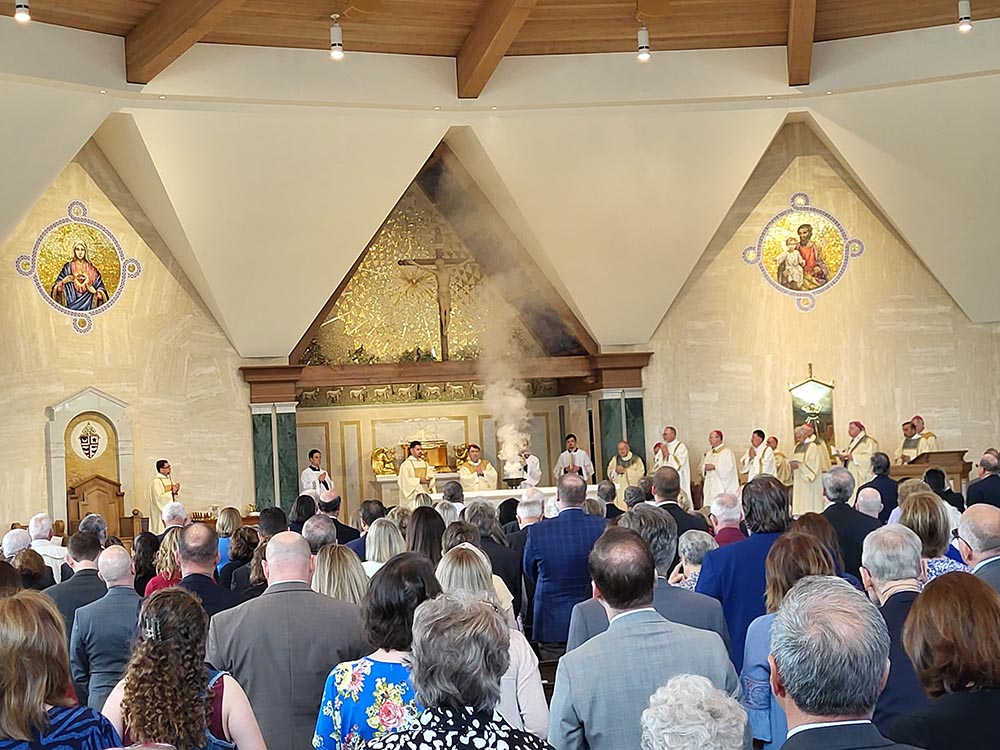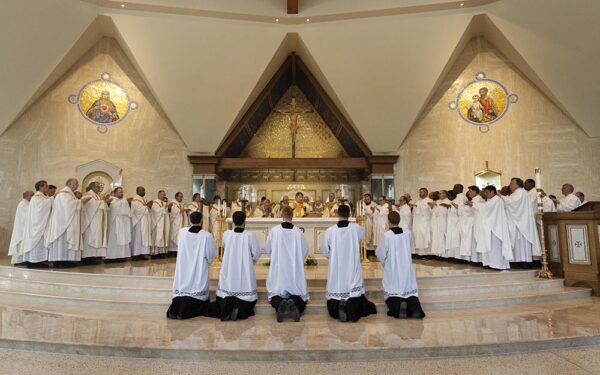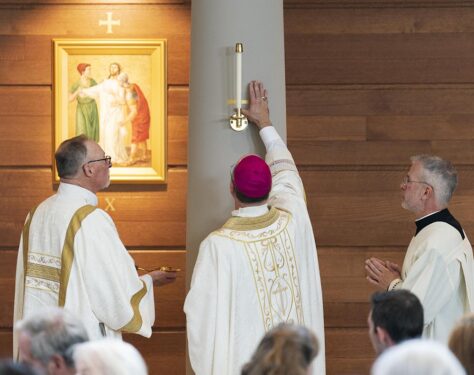
By Jay Nies
JEFFERSON CITY, Mo. (OSV News) — A vigil candle once again flickers through light and darkness. The Blessed Sacrament stays present in renewed quarters, precious and imperishable.
Hints of incense and chrism and candle wax linger. Warm lights animate the artwork throughout the open, inviting, acoustically resilient enclosure.
As always, Christ is at the center.
“In this sacred space, we encounter the living God in the proclamation of the Word, in the celebration of the sacraments, in the persons of the holy ministers, and in the sacred assembly — you!” Bishop W. Shawn McKnight proclaimed from the ambo of the newly renewed and expanded Cathedral of St. Joseph in Jefferson City.
“It is in this place that God sanctifies us, and we bless God in response with hearts full of gratitude and thanksgiving,” he stated in his homily for the Mass of rededication the morning of May 5.
Archbishop Christophe Pierre, papal nuncio to the United States, presided at the Mass and anointed the new altar with sacred chrism.
Concelebrating the Mass with him and Bishop McKnight were all of Missouri’s Catholic bishops, including Archbishop Mitchell T. Rozanski of St. Louis and retired Bishop John R. Gaydos of Jefferson City, along with the priests of this diocese.
It was the 49th anniversary of the original dedication of the cathedral in the centennial year of the death of Jesuit Father Ferdinand Helias, a 19th-century Belgian-born priest called the “Apostle of Central Missouri” for establishing several Catholic parishes and missions.
The rededication Mass, filled with rituals, symbols and prayers harkening back to biblical times, marked the near-completion of a comprehensive, 16-month renovation and expansion of the cathedral to make it functional and timelessly Catholic for current and future generations.
“With holy water, chrism, and the Eucharist, the liturgy of dedicating a church and altar for God’s service reveals just how important the physical structure of the cathedral is to our faith and mission to evangelize,” Bishop McKnight pointed out.
Freshly cast bells in new towers rang out glad tidings while archbishops, bishops, priests and deacons in brand new vestments passed under the portico, across the threshold and through the greatly enlarged narthex.
Bishop McKnight noted in his homily that Catholic churches stand as sacred symbols — “reminders to the whole community of the presence of God and the presence of the real church that is you — the people who are the living stones of God’s holy temple.”
He spoke of the weaving together of classical, traditional and contemporary artistic styles throughout the renovated cathedral “to manifest our communion with the one church across the centuries.”
He pointed out the newly painted “IHS” mural affixed to the oculus at the peak of the cathedral’s crown-shaped roof. Embellished with a cross and sunburst against a sky-blue background, those first three letters in Greek for the name of Jesus identify the assembly gathered below it as the body of Christ.
In that and so many other ways, the cathedral functionally symbolizes and communicates the mystical union — known as communion — that all Catholics share, especially those of the same diocese.
“On the night before he died, Jesus prayed that we might be one as he and the Father are one,” Bishop McKnight noted. “Our communion with one another in the faith of Jesus Christ and with his church needs to be strong so that we may fulfill the mission he has given to us in our time and in our place.”
Like the resplendent but as-yet uncompleted cathedral, this sacred communion remains under construction. (New stained-glass windows, bronze doors and a new pipe organ are to be installed in the months to come.)
“We as individuals and corporately as the church are still works in progress when it comes to our communion with God and one another,” Bishop McKnight acknowledged.
All are on a journey of conversion to living the light of Christ in a world that desperately needs it, he said.
Donors are paying entirely for the renewal of the cathedral proper, with Cathedral of St. Joseph Parish funding the rehabilitation of the downstairs undercroft, now known as Cana Hall.

Completed in 1968, the cathedral was originally designed with many of the ideals of the Second Vatican Council (1962-65). Among these are a circular configuration that highlights the importance of the assembled communicants and their active participation in the sacred mysteries.
The renovations embody even more of those ideals, including a conspicuously situated baptistery that highlights the dignity of the sacrament of baptism and the universal call to holiness that flows from it.
Likewise, the bishop noted, “the pillars surrounding the assembly evoke the foundation of the Apostles, on which our church rests.”
He also noted a new large repository for sacred chrism (used for anointing) in the sanctuary symbolizes “that the gift of the Spirit that continues to be poured out on us through the ministry of the successors to the apostles.”
The new ambo, from which the Scriptures are proclaimed, gives prominence to the preaching of the Word and relates to the altar.
“With the image of Christ crucified up front, and the mosaic of the Resurrection and the gift of the Spirit from the Father and the Son in the background, we see in one view the whole Paschal Mystery,” Bishop McKnight asserted.
Below the crucifix and mosaic are the tabernacle, where the Blessed Sacrament is reposed, and the altar, the central focus of the entire cathedral, “upon which the source and summit of our Christian life is carried out.”
The rededication of a physical structure for sacred purposes also marks “our renewal of dedication to God through our belief in the teachings of the Catholic Church, through our charitable works, and through our sacramental life,” Bishop McKnight said.
“These three things are the way we mark our belonging to the Catholic Church,” he stated.
At the Mass, priests and other representatives of each of the five deaneries in the diocese processed in behind their deanery’s banner, each adorned with an emblem from the diocesan coat of arms.
Members of the Cathedral Renovation Commission and the architects, contractors and artists took part in a ceremonial handing-over of the cathedral.
Archbishop Pierre blessed water and used it to cleanse the altar and to sprinkle holy water on the people with the help of several concelebrating bishops.
He placed the relics of 10 saints — St. Aurelius, St. Benedict, St. Clement, St. Francis de Sales, St. Iranaeus, St. Isidore, St. John Vianney, St. Martin de Porres, St. Rose Philippine Duchesne and St. Vincent de Paul — in a reliquary inside the new altar.
Afterward, he offered up the prayer of dedication, imploring the Father to help “your faithful, gathered around the table of the altar, celebrate the memorial of the Paschal Mystery and be refreshed by the banquet of Christ’s word and his body.”

Following the chanting of the litany of saints by the choir and congregation, Archbishop Pierre prayed the prayer of consecration. He poured sacred chrism in the outline of a cross upon the altar’s center and four corners, then carefully spread with his hands the sweet-scented chrism across the entire surface.
Archbishop Rozanski, Bishop James V. Johnston Jr. of Kansas City-St. Joseph, Bishop Edward M. Rice of Springfield-Cape Girardeau and Bishop McKnight then went forth to anoint the pillars, applying chrism in the shape of a cross.
The deans of each of the five deaneries presented five thuribles filled with incense at the altar, then incensed the rest of the cathedral and the people.
Deacons, servers and members of the cathedral renovation commission then came forward to set the candles, flowers and altar linens in place.
As the candles were lit and the lights were turned on, the choir led the congregation in singing “Your light has come, Jerusalem; the nations will walk in your light. Alleluia!”
After holy Communion, while choir and congregation chanted “Tantum Ergo,” a traditional hymn of Eucharistic adoration, Archbishop Pierre carried the Blessed Sacrament in procession to the new tabernacle behind the altar.
Bishop McKnight said that while the true Church of God is made up of living stones, with Christ as the capstone, the cathedral is nonetheless a necessary and effective means of evangelization.
“This cathedral stands as both a sign and symbol of our communion in the Catholic faith in what we believe, in how we live as Catholics, and in the celebration of the sacraments — especially the supreme Sacrament that is the Eucharist,” he said.
“May we continue the hard work of journeying together on the path to greater communion,” he proclaimed, “inviting all to recognize this place as their spiritual home. Let us give thanks to the Lord!”
